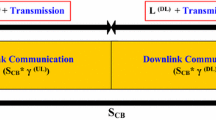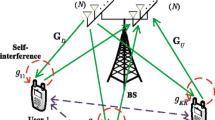Abstract
Large-scale multi-user multiple input multiple output (LS-MU-MIMO) is a promising technology to meet the demands for higher spectral and energy efficiency in the next-generation communication system. LS-MU-MIMO technology can provide 50 times or more network throughput by enhancing the spectral efficiency without cell densification and extra bandwidth requirements. This paper focuses on improvement in the spectral and energy efficiency for a single-cell LS-MU-MIMO system by considering multiple antennas at the user end with the linear precoding schemes. Spectral efficiency of zero-forcing (ZF), minimum mean square error (MMSE) and maximum ratio transmission (MRT) precoding schemes are derived, analyzed and compared for single- and double-antenna users with perfect and imperfect channel state information (CSI). MMSE precoding scheme shows the optimum spectral efficiency as compared to MRT and ZF precoding schemes for a LS-MU-MIMO system. We consider downlink and uplink transmission with various processing techniques at the base station and designed a system model for power consumption to evaluate the energy efficiency of the large MU-MIMO system. We derived energy efficiency expressions for maximal ratio, zero-forcing (ZF) and MMSE processing schemes. Numerical results reveal that the energy efficiency with double-antenna user equipments (UEs) has been enhanced as compared to the UEs having single antenna. Simulation results show that the proposal of adding multiple antennas at the user end can provide a substantial improvement in spectral and energy efficiency as compared to single-antenna users for perfect and imperfect CSI with various precoding schemes.










Similar content being viewed by others
References
Cooper, M.: The myth of spectrum scarcity. Tech. rep.DYNAllc. https://ecfsapi.fcc.gov/file/7020396128.pdf (2010)
IWPC International Wireless Industry Consortium: Evolutionary & disruptive visions towards ultra-high capacity networks. White paper, Version 1.1 (2014)
Wong, V.; Schober, R.; Ng, D.W.K.; Wang, L.: Key Technologies for 5G Wireless Systems, 1st edn. Cambridge University Press, Cambridge (2017)
Boccardi, F.; Clerckx, B.; Ghosh, A.; Hardouin, E.; Jongren, G.; Kusume, K.; Onggosanusi, E.; Tang, Y.: Multiple antenna techniques in LTE-advanced. IEEE Commun. Mag. 50(3), 114–121 (2012)
Gesbert, D.; Kountouris, M.; Heath, R.W.; Chae, C.B.; Salzer, T.: Shifting the MIMO paradigm. IEEE Signal Process. Mag. 24(5), 36–46 (2007)
Marzetta, T.L.: Noncooperative cellular wireless with unlimited numbers of base station antennas. IEEE Trans. Wirel. Commun. 9(11), 3590–3600 (2010)
Merzetta, T.L.: Massive MIMO: an introduction. Bell Labs Tech. J. 20, 11–22 (2015)
Rusek, F.; Persson, D.; Lau, B.K.; Larsson, E.G.; Marzetta, T.L.; Edfors, O.; Tufvesson, F.: Scaling up MIMO: opportunities and challenges with very large arrays. IEEE Signal Process. Mag. 30(1), 40–60 (2013)
Larsson, E.G.; Edfors, O.; Tufvesson, F.; Marzetta, T.L.: Massive MIMO for next generation wireless systems. IEEE Commun. Mag. 52(2), 186–195 (2014)
Auer, G.; et al.: D2.3: energy efficiency analysis of the reference systems, areas of improvements and target breakdown. INFSO-ICT-247733 EARTH, ver. 2.0, 2012. http://www.ict-earth.eu/
Prasad, K.N.R.S.V.; Hossain, E.; Bhargava, V.K.: Energy efficiency in massive MIMO-based 5G networks: opportunities and challenges. IEEE Wirel. Commun. 24(3), 86–94 (2017)
Wang, C.X.; Haider, F.; Gao, X.; You, X.H.; Yang, Y.; Yuan, D.; Aggoune, H.; Haas, H.; Fletcher, S.: Hepsaydir E: cellular architecture and key technologies for 5G wireless communication networks. IEEE Commun. Mag. 52(2), 122–130 (2014)
Tsilimantos, D.; Gorce, J.; Jaffrès-Runser, K.; Vincent Poor, H.: Spectral and energy efficiency trade-offs in cellular networks. IEEE Trans. Wirel. Commun. 15(1), 54–66 (2016)
Tombaz, S.; Vastberg, A.; Zander, J.: Energy- and cost-efficient ultra-high-capacity wireless access. IEEE Wirel. Commun. 18(5), 18–24 (2011). https://doi.org/10.1109/MWC.2011.6056688
Lu, L.; Li, G.Y.; Swindlehurst, A.L.; Ashikhmin, A.; Zhang, R.: An overview of massive MIMO: benefits and challenges. IEEE J. Sel. Top. Signal Process. 8(5), 742–758 (2014)
Zhao, L.; Zheng, K.; Long, H.; Zhao, H.: Performance analysis for downlink massive MIMO system with ZF precoding. Trans. Emerg. Telecommun. Technol. 25(12), 1219–1230 (2014)
Yang, H.; Marzetta, T.L.: Performance of conjugate and zero-forcing beamforming in large-scale antenna systems. IEEE J. Sel. Areas Commun. 31(2), 172–179 (2013)
Hoydis, J.; Ten Brink, S.; Debbah, M.: Massive MIMO in the UL/DL of cellular networks: how many antennas do we need? IEEE J. Sel. Areas Commun. 31(2), 160–171 (2013)
Ngo, H.Q.; Larsson, E.G.; Marzetta, T.L.: Energy and spectral efficiency of very large multiuser MIMO systems. IEEE Trans. Commun. 61(4), 1436–1449 (2013)
Lim, Y.G.; Chae, C.; Caire, B.G.: Performance analysis of massive MIMO for cell-boundary users. IEEE Trans. Wirel. Commun. 14(12), 6827–6842 (2015)
Zhang, Q.; Jin, S.; Wong, K.K.; Zhu, H.; Matthaiou, M.: Power scaling of uplink massive MIMO systems with arbitrary-rank channel means. IEEE J. Sel. Top. Signal Process. 8(5), 966–981 (2014)
Li, L.; Shen, D.; Tian, X.; Chen, G.; Pham, K.; Blasch, E.: A joint PDA data detection algorithm with MMSE channel estimation for uplink transmission of massive MU-MIMO system. In: IEEE Aerospace Conference, Big Sky, MT, pp. 1–7 (2018)
Lu, Z.; Zhu, D.; Zhang, X.; Chen, X.: SINR prediction based on MU-MIMO in large scale antenna array system. In: International Conference on Wireless Communications and Signal Processing, Hangzhou, pp. 1–4 (2013)
Yang, A.; He, Z.; Xing, C.; Fei, Z.; Kuang, J.: The role of large-scale fading in uplink massive MIMO systems. IEEE Trans. Veh. Technol. 65(1), 477–483 (2016)
Krishnan, R.; Khanzadi, M.R.; Krishnan, N.; Wu, Y.; Graell i Amat, A.; Eriksson, T.; Schober, R.: Linear massive MIMO precoders in the presence of phase noise—a large-scale analysis. IEEE Trans. Veh. Technol. 65(5), 3057–3071 (2016)
Ganji, M.; Jafarkhani, H.: On the performance of MRC receiver with unknown timing mismatch—a large scale analysis. In: IEEE International Conference on Communications (ICC), Kansas City, MO, pp. 1–6 (2018)
Tran, H.; Mai, T.; Dang, S.; Ngo, H.: Large-scale MU-MIMO uplink channel estimation using sounding reference signal. In: 2nd International Conference on Recent Advances in Signal Processing, Telecommunications & Computing (SigTelCom), Ho Chi Minh City, pp. 107–110 (2018)
Liu, M.; Zhang, J.; Xu, C.; Zhang, P.; Wu, Y.: Non-asymptotic outage probability of large-scale MU-MIMO systems with linear receivers. In: IEEE 84th Vehicular Technology Conference (VTC-Fall), Montreal, QC, pp. 1–5 (2016)
Li, X.; Bjornson, E.; Larsson, E.G.; Zhou, S.; Wang, J.: A multi-cell MMSE detector for massive MIMO systems and new large system analysis. In: Proceedings of the IEEE Global Communications Conference (GLOBECOM), San Diego, CA, pp. 1–6 (2015)
Park, C.S.; Byun, Y.S.; Bokiye, A.M.; Lee, Y.H.: Complexity reduced zero-forcing beamforming in massive MIMO systems. In: Information Theory and Applications Workshop (ITA), San Diego, CA, pp. 1–5 (2014)
Yang, H.H.; Geraci, G.; Quek, T.Q.S.; Andrews, J.G.: Cell-edge-aware precoding for downlink massive MIMO cellular networks. IEEE Trans. Signal Process. 65(13), 3344–3358 (2017)
Parfait, T.; Kuang, Y.; Jerry, K.: Performance analysis and comparison of ZF and MRT based downlink massive MIMO systems. In: Proceedings of the Sixth International Conference on Ubiquitous and Future Networks (ICUFN), Shanghai, pp. 383–388 (2014)
Gao, X.; Edfors, O.; Rusek, F.; Tufvesson, F.: Linear pre-coding performance in measured very-large MIMO channels. In: IEEE Vehicular Technology Conference (VTC Fall), San Francisco, CA, pp. 1–5 (2011)
Bahrami, H.R.; Le-Ngoc, T.: Maximum ratio combining precoding for multi-antenna relay systems. In: IEEE International Conference on Communications, Beijing, pp. 820–824 (2008)
Zhu, X.; et al.: Soft pilot reuse and multicell block diagonalization precoding for massive MIMO systems. IEEE Trans. Veh. Technol. 65(5), 3285–3298 (2016)
Ahlin, L.: Principles of Wireless Communications. Studentlitteratur AB, Lund (2006)
Björnson, E.; Hoydis, J.; Kountouris, M.; Debbah, M.: Massive MIMO systems with non-ideal hardware: energy efficiency, estimation, and capacity limits. IEEE Trans. Inf. Theory 60(11), 7112–7139 (2014)
Kumar, R.V.R.; Gurugubelli, J.: How green the LTE technology can be?. In: 2011 2nd International Conference on Wireless Communication, Vehicular Technology, Information Theory and Aerospace & Electronic Systems Technology (Wireless VITAE), Chennai, pp. 1–5 (2011)
Yang, H.; Marzetta, T.: Total energy efficiency of cellular large scale antenna system multiple access mobile networks. In: Proceedings of IEEE Online Conference on Green Communications (OnlineGreenComm) (2013)
Hu, Y.; Ji, B.; Huang, Y.; Yu, F.; Yang, L.: Energy-efficiency resource allocation of very large multi-user MIMO systems. Wirel. Netw. 20, 1421–1430 (2014)
Björnson, E.; Kountouris, M.; Debbah, M.: Massive MIMO and small cells: improving energy efficiency by optimal soft-cell coordination. In: Proc. Int. Conf. Telecommun. (ICT) (2013)
Ha, D.; Lee, K.; Kang, J.: Energy efficiency analysis with circuit power consumption in massive MIMO systems. In: Proc. IEEE Int. Symp. Personal, Indoor and Mobile Radio Commun. (PIMRC) (2013)
Miao, G.: Energy-efficient uplink multi-user MIMO. IEEE Trans. Wirel. Commun. 12(5), 2302–2313 (2013)
Mohammed, S.K.: Impact of transceiver power consumption on the energy efficiency of zero-forcing detector in massive MIMO systems. IEEE Trans. Commun. 62(11), 3874–3890 (2014)
Pillai, S.; Suel, T.; Cha, S.: The Perron-Frobenius theorem: some of its applications. IEEE Signal Process. Mag. 22(2), 62–75 (2005)
Wiesel, A.; Eldar, Y.; Shamai, S.: Linear precoding via conic optimization for fixed MIMO receivers. IEEE Trans. Signal Process. 54(1), 161–176 (2006)
Björnson, E.; Jorswieck, E.: Optimal resource allocation in coordinated multi-cell systems. Found. Trends Commun. Inf. Theory 9(2–3), 113–381 (2013)
Boche, H.; Schubert, M.: A general duality theory for uplink and downlink beamforming. In: Proc. IEEE VTC-Fall, pp. 87–91 (2002)
Peel, C.B.; Hochwald, B.M.; Swindlehurst, A.L.: A vector-perturbation technique for near-capacity multiantenna multiuser communication-part I: channel inversion and regularization. IEEE Trans. Commun. 53(1), 195–202 (2005)
Mazrouei-Sebdani, M.; Krzymień, W.A.; Melzer, J.: Massive MIMO with nonlinear precoding: large-system analysis. IEEE Trans. Veh. Technol. 65(4), 2815–2820 (2016)
Joham, M.; Utschick, W.; Nossek, J.A.: Linear transmit processing in MIMO communications systems. IEEE Trans. Signal Process. 53(8), 2700–2712 (2005)
Björnson, E.; Sanguinetti, L.; Hoydis, J.; Debbah, M.: Designing multi-user MIMO for energy efficiency: when is massive MIMO the answer?. In: 2014 IEEE Wireless Communications and Networking Conference (WCNC), Istanbul, pp. 242–247 (2014)
Kumar, R.; Gurugubelli, J.: How green the LTE technology can be?. In: Proc. Wireless VITAE (2011)
Boyd, S.; Vandenberghe, L.: Numerical linear algebra background. http://www.ee.ucla.edu/ee236b/lectures/num-lin-alg.pdf
Mezghani, A.; Nossek, J.A.: Power efficiency in communication systems from a circuit perspective. In: Proc. IEEE Int. Symp. Circuits and Systems (ISCAS), pp. 1896–1899 (2011)
Tombaz, S.; Sung, K.; Zander, J.: Impact of densification on energy efficiency in wireless access networks. In: Proc. IEEE Global Commun. Conf. (GLOBECOM) (2012)
ITU: Requirements related to technical performance for imt-advanced radio interface(s).Tech.rep., ITU-RM.2134
Author information
Authors and Affiliations
Corresponding author
Rights and permissions
About this article
Cite this article
Singh, J., Kedia, D. Performance Improvement in Large-Scale MU-MIMO System with Multiple Antennas on User Side in a Single-Cell Downlink System. Arab J Sci Eng 45, 6769–6789 (2020). https://doi.org/10.1007/s13369-020-04714-0
Received:
Accepted:
Published:
Issue Date:
DOI: https://doi.org/10.1007/s13369-020-04714-0




